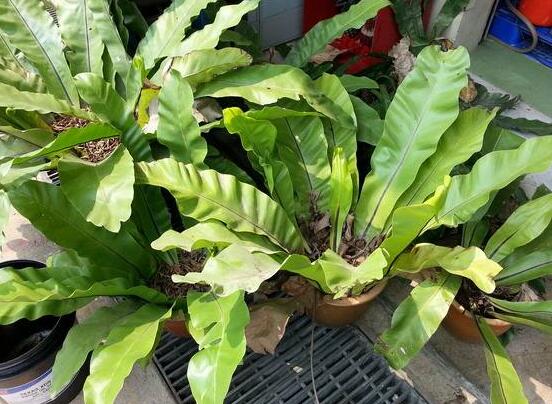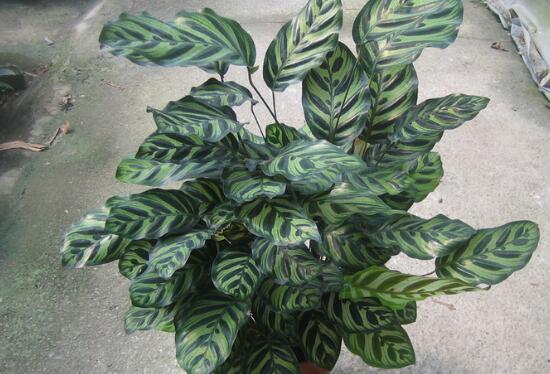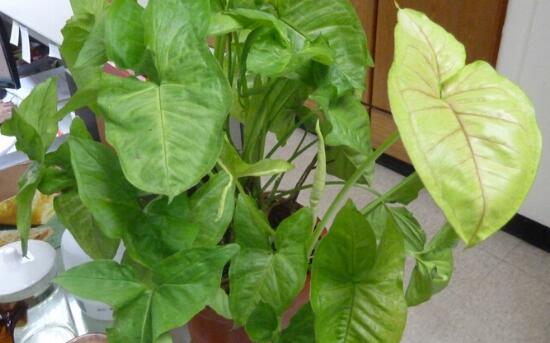How to raise bird's nest fern, how to raise bird's nest fern and precautions / don't get too much light
Among foliage plants, bird's nest ferns are famous for their green and large leaves, and they have many functions and benefits, so they raise a lot of people, so is it easy to raise bird's nest ferns? The answer is very easy to raise, but how to raise bird's nest ferns? Let's take a look at the breeding methods and precautions of bird's nest fern.
Is the bird's nest fern easy to raise?

According to the planting experience of flower friends, bird's nest fern is very easy to raise a plant. It only needs to be given a semi-shady environment, and it can grow normally without long-term lack of water, fertilizer and light. Of course, if you want to raise it well, you still need some skills.
How to raise bird's nest fern
Let's learn about its growth habits before planting. First of all, bird's nest fern is a kind of plant that likes semi-shade environment. It is not tolerant to strong light and is especially afraid of being exposed to direct sunlight for too long. Its cold resistance is also general, more like the humid environment, so we should pay attention to reasonable watering. Bird's nest ferns prefer sandy soil on soil.
Culture methods and matters needing attention of bird nest fern
I. Culture methods
1. Soil
When potted, the soil should be mainly rotten leaf soil, peat soil, vermiculite, which can be mixed with some river sand to increase the air permeability and drainage of the soil. It is also best to use porous flowerpots, which can increase the air permeability of the flowerpots and make the root breathe more smoothly.
2. Lighting
In the breeding methods and precautions of bird's nest fern, light is a very important factor, because the bird's nest fern is sensitive to light, it only needs a small amount of scattered light to grow, and is afraid of direct light, so it needs to block 70% of the sun in summer.
3. Temperature
The most suitable temperature is 16-27 degrees, and the temperature can be maintained between 22 and 27 degrees from March to October. Shading and cooling are needed if the temperature exceeds 30 degrees, so as to ensure that it can also grow vigorously in summer. In winter, we need to keep the temperature above 5 degrees to prevent roots and leaves from being withered by frostbite.
4. Watering
Bird's nest ferns like moist soil and high air humidity, so they need to be watered frequently during the growing season and spray more water in summer to ensure that the humidity can reach the ideal state. When the temperature is low in winter, you only need to keep the soil slightly moist, you can water less and spray water.
5. Fertilizer
Because the bird's nest fern has dense scales, its rhizome can also produce a lot of spongy fibrous roots, which can absorb and store a lot of water, so there is no need for excessive fertilization in the peak growth period. in general, organic fertilizer of nitrogen, phosphorus and potassium is applied every 15 days, if the frequent lack of fertilizer will cause the leaf margin to turn brown, affecting the ornamental effect of bird's nest fern on the benefits.
II. Points for attention
1. Soil disinfection. No matter what type of soil is used, it is best to do disinfection first, but it can be dried in the sun or soaked in disinfectant, in short, it should be free of germs and eggs, otherwise it is easy to cause root rot, which will cause the plant to grow slowly.
2. Potting skills. Small potted plants generally use flowerpots with a caliber of about 9 centimeters. It is best to pad about 2 centimeters of matrix in the basin before planting, and then move the seedlings to the pot. Do not plant too deep, and the matrix is compacted but not too tight.
3. Prevention of diseases and insect pests. Bird's nest fern is easy to catch anthrax, and may also encounter the harm of nematodes, so it is necessary to do a good job of maintenance and management at ordinary times, such as humidity is not easy to be too high, and the light is not too strong or too weak, and use chlorothalonil wettable powder to control the disease.
How to raise bird nest fern, breeding methods and matters needing attention of bird nest fern
Bird's nest fern is an epiphytic fern native to southeast Asia, eastern Australia, Indonesia, India and eastern Africa, and is widely distributed in tropical China. How to raise bird's nest fern? This paper introduces the breeding methods and matters needing attention of bird nest fern.
The culture method of bird's nest fern
1. Planting: peat soil or rotten leaf soil is the best in potted bird nest fern soil. The growth depends on planting nest fern for 2-3 years, the plant shape is open, and the root is full of pot rack, which can be protruded from the basin, and some residual roots and spore leaves withered at the base can be removed, taken out in the plant and replanted in the pot respectively. When changing the basin in spring, rotten leaf soil and moss should be added to the basin, and a little gravel should be added.
2. Temperature and light: the suitable temperature for the growth of bird's nest fern is 22-27 ℃. It should be shaded in summer or placed in a sparse place under a big tree to avoid strong direct sunlight, which is beneficial to growth and make the leaves glossy. Put it in a brightly lit place indoors, not in the dark for a long time. It should be moved into the greenhouse in winter and the temperature should be kept above 16 ℃ so that it can continue to grow, but the lowest temperature should not be lower than 5 ℃.
3. Watering and fertilization: under the condition of high temperature and humidity in summer, the vigorous growth of new leaves needs more water, fully spray the leaf surface and maintain a higher air temperature, which is beneficial to spore germination. With the increase of the leaves, the leaves are often covered with the culture soil in the basin, and the pot must be watered thoroughly in order to avoid the dry and curl of the leaves caused by the lack of water.
Matters needing attention in breeding bird nest fern
1. Bird's nest fern is suitable to grow in peat soil or rotten leaf soil, and the suitable temperature for bird's nest fern growth is 22 ~ 27 degrees Celsius.
2. Under the condition of high temperature and humidity in summer, the growth of new leaves needs more water, and maintaining the humidity of the air is beneficial to the germination of spores.
3. The breeding of bird's nest fern does not need too much sunshine, just the right amount.
4. The growing season of bird's nest fern should be fully watered, and the basin soil should be kept moist when the room temperature is low in winter.
The above is the introduction of the breeding methods and matters needing attention of the bird nest fern. I believe we already know how to raise the bird nest fern. The function of bird's nest fern is mainly reflected in the use and potted plants. Bird's nest fern can be used as potted and planted plants, its leaves are excellent flowers, and the curled young leaves can be fried, cooked or made as kimchi. Bird's nest fern has a slightly bitter taste and can be used for heat-clearing and detoxification.
How to raise bird nest fern breeding methods and matters needing attention
There are many kinds of ferns, and bird's nest fern is one of them. How to raise bird's nest fern? Today we are going to tell you the breeding methods and matters needing attention of bird's nest fern.
Introduction of bird's nest fern
Bird's nest fern, also known as nest fern, crown fern and mountain perennial fern, is a perennial herb of the genus Dryopteris of the family Pteridaceae. The plant grows upright, and the leaf radiates directly on the rhizome, forming a rosette. There is a column in the middle of the rosette, which is wrapped with black fibers, which looks like a bird's nest, hence the name "bird's nest fern". The leaf is uncracked, broad lanceolate, about 20 cm wide, up to 1 m long, and the length is generally controlled at 30 cm to 50 cm, or even shorter. Mature leaves abaxially with long and narrow sporangia along lateral veins. The leaves are bright green, leathery and glossy. The dorsal midrib of the leaf is prominent and gradually deepens to the base and is black. Bird's nest fern can be used for large and medium-sized potted plants or hanging pots, decorating brightly lit living rooms, living rooms, conference rooms and other places, full of vitality.
Bird's nest ferns like warm and humid semi-shady environment, not cold-resistant, but also afraid of drought, avoid hot sun exposure. It can be maintained in bright indoor light or other places where there is no direct sunlight. If the light is not enough, the leaves will become thin and wide, bright green, and too strong light will make the leaves yellowing and hinder their growth. Therefore, attention should be paid to the control of light in cultivation. Water frequently during the growing period to keep the soil moist, but to avoid stagnant water in the basin soil. Often sprinkle water on the plant and its surrounding environment to increase the humidity of the air so that the air is too dry, causing the edges of the leaves to wither and turn brown. The mature thin liquid fertilizer or inorganic liquid fertilizer is applied every 10 days in the growing season to promote the growth of new leaves and make the leaf color bright and beautiful, otherwise the lack of fertilizer can easily lead to smaller leaves and dim leaf color. In winter, the plant can continue to grow when the indoor light is sufficient and the temperature is kept above 15 ℃. If the temperature is lower than 10 ℃, the plant will suffer frost damage. Turning the basin every two or three years in spring, the basin soil requires good drainage and air permeability, which can be mixed with peat, rotten leaf soil and a small amount of mature horse dung, and can also be planted with artificial synthetic materials such as ceramsite, but nutrients should be replenished in time. Bird's nest ferns cultivated in greenhouses can also grow on trees or rocks.
Bird's nest ferns can be propagated by ramet or sowing spores. Ramet combined with pot change, the tufted plants were divided with leaves and roots, and each clump had 5 to 7 leaves, respectively. The solitary and robust plant can also be cut into 4 pieces from the basal part, and the leaves can be shortened from 1 to 2, so that each piece has leaves, rhizomes and roots, and then put on the pot separately, and the original plant shape can be gradually restored after the new leaves grow out. The newly potted plants should be maintained in a semi-shady place above 20 ℃. Pay attention to keeping the air moist, but the soil should not be too moist, otherwise it will rot easily. Sowing spores can be carried out in March or July or August, scraping mature spores from the back of leaves, sowing them in rotten leaf soil, covering them with plastic film, taking root and moving them into sandy soil rich in humus.
2. Culture methods of bird's nest fern
1. Planting: peat soil or rotten leaf soil is the best in potted bird nest fern soil. The growth depends on planting nest fern for 2-3 years, the plant shape is open, and the root is full of pot rack, which can be protruded from the basin, and some residual roots and spore leaves withered at the base can be removed, taken out in the plant and replanted in the pot respectively. When changing the basin in spring, rotten leaf soil and moss should be added to the basin, and a little gravel should be added.
2. Ramet: you can split the bird's nest fern in the last ten days of April every year. Generally, select the strong growing plant, cut its rhizome together with leaves and root clumps into several pieces, or cut off the side plants, cut off the 1x2 of the leaves, put them on the pot and cover them with a small amount of rotten leaf soil, so as to create a small environment with good moist ventilation and good drainage. The ambient temperature should be controlled at about 25 degrees. This kind of survival rate is relatively high, when watering it, we should pay attention to the basin soil can not be too wet, so as not to cause rotten roots. Ramet is the most effective breeding method for flower lovers.
3. Temperature and light: the suitable temperature for the growth of bird's nest fern is 22-27 ℃. It should be shaded in summer or placed in a sparse place under a big tree to avoid strong direct sunlight, which is beneficial to growth and make the leaves glossy. Put it in a brightly lit place indoors, not in the dark for a long time. It should be moved into the greenhouse in winter and the temperature should be kept above 16 ℃ so that it can continue to grow, but the lowest temperature should not be lower than 5 ℃.
4. Watering and fertilization: under the condition of high temperature and humidity in summer, the vigorous growth of new leaves needs more water, fully spray the leaf surface and maintain a higher air temperature, which is beneficial to spore germination. With the increase of the leaves, the leaves are often covered with the culture soil in the basin, and the pot must be watered thoroughly in order to avoid the dry and curl of the leaves caused by the lack of water.
Matters needing attention in breeding bird's nest fern
1. Bird's nest fern is suitable to grow in peat soil or rotten leaf soil, and the suitable temperature for bird's nest fern growth is 22 ~ 27 degrees Celsius.
2. Under the condition of high temperature and humidity in summer, the growth of new leaves needs more water, and maintaining the humidity of the air is beneficial to the germination of spores.
3. The breeding of bird's nest fern does not need too much sunshine, just the right amount.
4. The growing season of bird's nest fern should be fully watered, and the basin soil should be kept moist when the room temperature is low in winter.
Fourth, the function of bird's nest fern
Bird's nest fern has ornamental value, garden value, medicinal value, edible value as a whole, the main value is obvious, loved by many people. Bird's nest fern is an effective air freshener, which absorbs carbon dioxide and releases a large amount of oxygen through photosynthesis, making the closed indoor air fresh. Bird's nest fern is rich in vitamin A, potassium, iron, calcium and dietary fiber, which can strengthen muscles and bones, promote blood circulation and remove blood stasis, and can also be used for fall injury, fracture, blood stasis, headache, hemolysis, impotence, gonorrhea and so on. And the bud of the bird's nest fern is also a delicious meal after the process in the kitchen.
- Prev

Is it easy to raise peacock taro? how to raise peacock taro in winter / clean leaves once a month
Beautiful peacock taro, flower friends should be no stranger, it is evergreen, with peacock open screen pattern of leaves, let people see a deep impression, then peacock taro easy to raise? It is understood that peacock taro likes a warm environment, so whether it is good or not depends mainly on winter. How to raise peacock taro in winter?
- Next

What about the yellowing of taro leaves? pay attention to 5: 00 yellowing without worry / improper water and fertilizer is the key.
For the fruit taro, flower friends should be no stranger, its leaves are green, the white line above is clear in color, like a dancing butterfly, looks very lovely. But in the process of breeding, because of improper operation, many flower friends will cause the yellowing of taro leaves, which will seriously affect the ornamental.
Related
- Fuxing push coffee new agricultural production and marketing class: lack of small-scale processing plants
- Jujube rice field leisure farm deep ploughing Yilan for five years to create a space for organic food and play
- Nongyu Farm-A trial of organic papaya for brave women with advanced technology
- Four points for attention in the prevention and control of diseases and insect pests of edible fungi
- How to add nutrient solution to Edible Fungi
- Is there any good way to control edible fungus mites?
- Open Inoculation Technology of Edible Fungi
- Is there any clever way to use fertilizer for edible fungus in winter?
- What agents are used to kill the pathogens of edible fungi in the mushroom shed?
- Rapid drying of Edible Fungi

